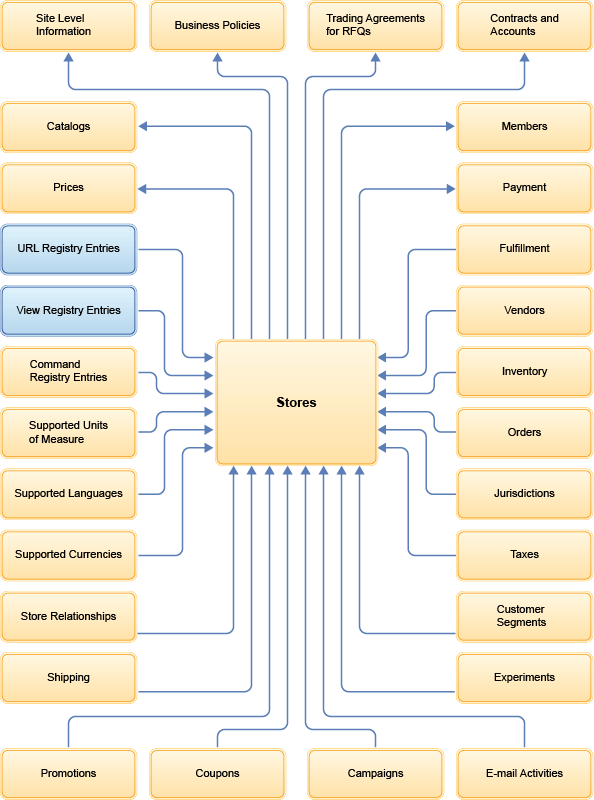Store data information model
Store data is the information that is loaded into the WebSphere Commerce Server database, which allows your store to function. The URL Registry Entries and View Registry Entries packages are included in the diagram, but they are not database assets. These entries are presentation configuration (that is, struts actions and forwards) that must be deployed. URL registry entries are shown in the diagram to illustrate the entire store data information model. To operate properly, a store must have the data in place to support all customer activities. For example, in order for a customer to make a purchase, your store must contain a catalog of goods for sale (catalog data), the data associated with processing orders (tax and shipping data), and the inventory to fulfill the request (inventory and fulfillment data).
An information model illustrates how store data is structured in the WebSphere Commerce Server. The WebSphere Commerce Server information model is a high-level abstraction of the information that is contained in the WebSphere Commerce Server data models. The information model highlights the most important features of the data models, but does not include the lower-level details that are specific to the schema and object implementations.
For example, certain tables and objects in the data model that contain entity-relationship data (such as foreign key pairs) are not represented in the information model as entities. Instead, these entity relationships are implied by the relationship lines between entities in the information models. The information model also differs from the data model. In the data model, each entity represents a table. In the information model, any of the objects depicted can be mapped to the same database table, or a single object can map to several database tables. The information model also does not illustrate detail extensions (data attributes of an entity that are stored in a separate table as a result of implementation concerns: for example, the product description is a separately stored extension of the product entity). Finally, unlike the data model, the information model can also illustrate concepts of inheritance.
The following diagram illustrates the data assets of a WebSphere Commerce store.

In the UML notation, a dotted line with an arrow that extends from an object and pointing to another object indicates that the first object has a dependency on the second object. In this diagram, the objects that are shown are as packages. Data in some packages, such as lists of Supported Currencies, are specific to a particular Store, and these packages are shown as dependent on the Store package. Other packages, such as Catalogs, are not specific to any particular Store. Each Store can use Catalogs, and thus the Store object is shown as dependent on the Catalogs package. As a result, the lists of Supported Currencies form part of a Store, while a Store uses Catalogs.